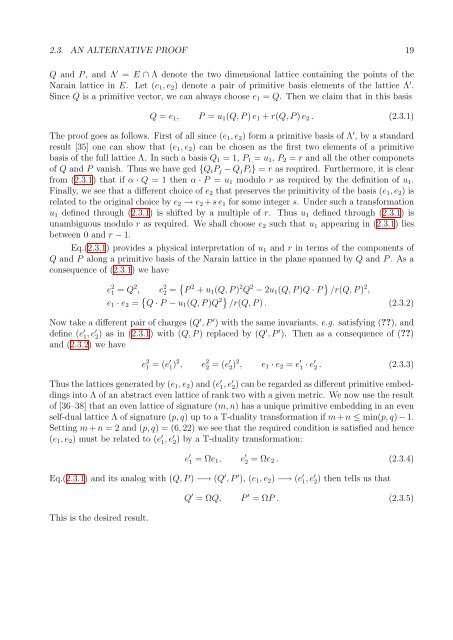PHYS08200604018 Shamik Banerjee - Homi Bhabha National ...
PHYS08200604018 Shamik Banerjee - Homi Bhabha National ...
PHYS08200604018 Shamik Banerjee - Homi Bhabha National ...
Create successful ePaper yourself
Turn your PDF publications into a flip-book with our unique Google optimized e-Paper software.
2.3. AN ALTERNATIVE PROOF 19<br />
Q and P , and Λ ′ = E ∩ Λ denote the two dimensional lattice containing the points of the<br />
Narain lattice in E. Let (e 1 , e 2 ) denote a pair of primitive basis elements of the lattice Λ ′ .<br />
Since Q is a primitive vector, we can always choose e 1 = Q. Then we claim that in this basis<br />
Q = e 1 , P = u 1 (Q, P ) e 1 + r(Q, P ) e 2 . (2.3.1)<br />
The proof goes as follows. First of all since (e 1 , e 2 ) form a primitive basis of Λ ′ , by a standard<br />
result [35] one can show that (e 1 , e 2 ) can be chosen as the first two elements of a primitive<br />
basis of the full lattice Λ. In such a basis Q 1 = 1, P 1 = u 1 , P 2 = r and all the other componets<br />
of Q and P vanish. Thus we have gcd {Q i P j − Q j P i } = r as required. Furthermore, it is clear<br />
from (2.3.1) that if α · Q = 1 then α · P = u 1 modulo r as required by the definition of u 1 .<br />
Finally, we see that a different choice of e 2 that preserves the primitivity of the basis (e 1 , e 2 ) is<br />
related to the original choice by e 2 → e 2 +s e 1 for some integer s. Under such a transformation<br />
u 1 defined through (2.3.1) is shifted by a multiple of r. Thus u 1 defined through (2.3.1) is<br />
unambiguous modulo r as required. We shall choose e 2 such that u 1 appearing in (2.3.1) lies<br />
between 0 and r − 1.<br />
Eq.(2.3.1) provides a physical interpretation of u 1 and r in terms of the components of<br />
Q and P along a primitive basis of the Narain lattice in the plane spanned by Q and P . As a<br />
consequence of (2.3.1) we have<br />
e 2 1 = Q 2 , e 2 2 = { P 2 + u 1 (Q, P ) 2 Q 2 − 2u 1 (Q, P )Q · P } /r(Q, P ) 2 ,<br />
e 1 · e 2 = { Q · P − u 1 (Q, P )Q 2} /r(Q, P ) . (2.3.2)<br />
Now take a different pair of charges (Q ′ , P ′ ) with the same invariants, e.g. satisfying (??), and<br />
define (e ′ 1, e ′ 2) as in (2.3.1) with (Q, P ) replaced by (Q ′ , P ′ ). Then as a consequence of (??)<br />
and (2.3.2) we have<br />
e 2 1 = (e ′ 1) 2 , e 2 2 = (e ′ 2) 2 , e 1 · e 2 = e ′ 1 · e ′ 2 . (2.3.3)<br />
Thus the lattices generated by (e 1 , e 2 ) and (e ′ 1, e ′ 2) can be regarded as different primitive embeddings<br />
into Λ of an abstract even lattice of rank two with a given metric. We now use the result<br />
of [36–38] that an even lattice of signature (m, n) has a unique primitive embedding in an even<br />
self-dual lattice Λ of signature (p, q) up to a T-duality transformation if m + n ≤ min(p, q) − 1.<br />
Setting m + n = 2 and (p, q) = (6, 22) we see that the required condition is satisfied and hence<br />
(e 1 , e 2 ) must be related to (e ′ 1, e ′ 2) by a T-duality transformation:<br />
e ′ 1 = Ωe 1 , e ′ 2 = Ωe 2 . (2.3.4)<br />
Eq.(2.3.1) and its analog with (Q, P ) −→ (Q ′ , P ′ ), (e 1 , e 2 ) −→ (e ′ 1, e ′ 2) then tells us that<br />
This is the desired result.<br />
Q ′ = ΩQ, P ′ = ΩP . (2.3.5)

















